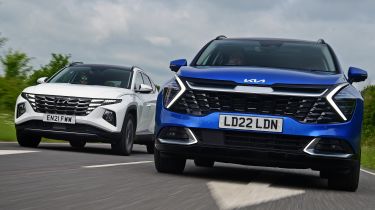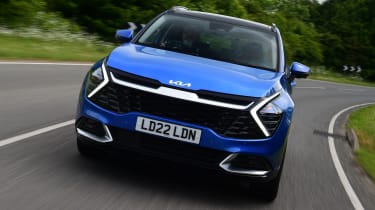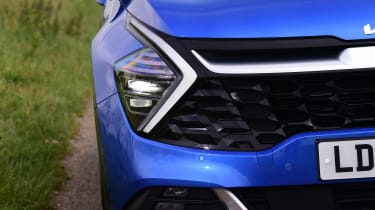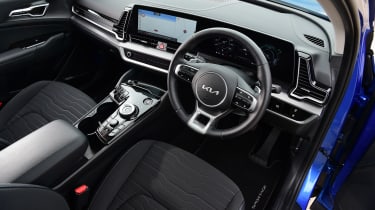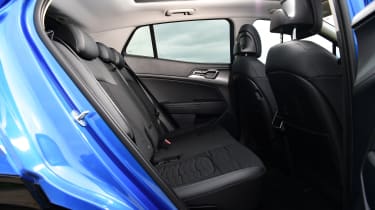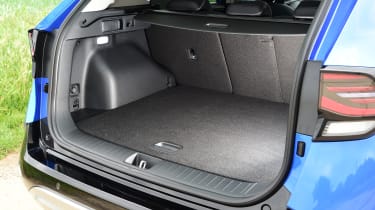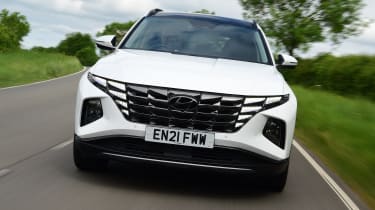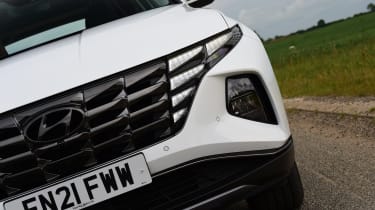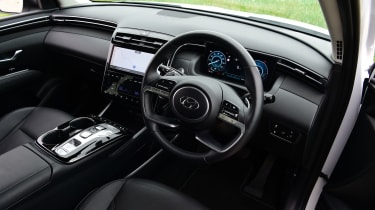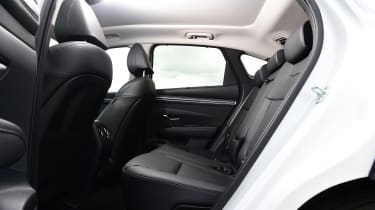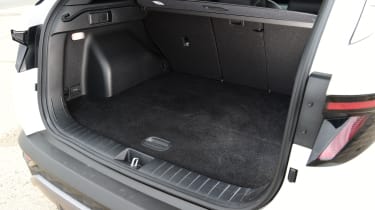Kia Sportage PHEV vs Hyundai Tucson PHEV: 2022 plug-in hybrid SUV twin test review
Plug-in hybrid versions of the Kia Sportage and Hyundai Tucson have a lot in common, but which one stands out?
If you’re looking for a family car with low running costs, then there are plenty of electric SUVs to consider. However, not everybody is convinced that a full EV can fit with their lifestyle, which is where the plug-in hybrid SUV comes in.
These machines deliver zero-emissions electric running for short trips, but there’s the backup of a combustion engine that allows you to plan longer journeys without the anxiety of wondering whether you’ll be able to charge up en route. Here we’ve lined up two more models that are well worth considering: the Hyundai Tucson and Kia Sportage.
The Sportage is the newer car, having only been launched earlier this year, but these two have a lot in common because they share the same platform, running gear, in-car tech and plug-in hybrid drivetrain. Picking a winner from the pair will be about the details, so we’ve looked closely at practicality, prices and running costs to determine which plug-in hybrid SUV will deliver the best all-round performance for family needs.
Kia Sportage
|
Model: |
Kia Sportage 1.6 T-GDi PHEV 4 AWD |
|
Price: |
£42,550 |
|
Powertrain: |
1.6-litre 4cyl turbo/e-motor, 261bhp |
|
0-62mph: |
7.9 seconds |
|
Test economy: |
44.6mpg/9.8mpl |
|
CO2: |
25g/km |
|
Annual road tax: |
£510 |
The all-new Kia Sportage arrived in dealers at the start of the year, and this plug-in hybrid version went on sale a couple of months later. The car in our pictures is a high-spec GT-Line model, but we’re testing 4 trim, which at £42,550 is £170 more than the Tucson in top-spec Ultimate trim.
Used - available now

2020 MINI
5-Door Hatch
42,441 milesAutomaticPetrol2.0L
Cash £17,050
2022 Toyota
Corolla Touring Sports
27,231 milesAutomaticPetrol1.8L
Cash £17,000
2021 Volkswagen
Touran
32,705 milesAutomaticDiesel2.0L
Cash £18,200
2018 SEAT
Ibiza
62,864 milesManualPetrol1.0L
Cash £8,900Design & engineering
Overall, the latest Kia Sportage is a fairly conventional SUV shape, but it’s marked out by some distinctive detailing. The broad grille and small, angular headlight units offer a talking point, while at the rear the tailgate design is reminiscent of the all-electric EV6, with the number plate set low and an expanse of bodywork separating the triangular tail-lamp clusters.
Plug-in hybrid models are a compromise, but the larger body used by a family SUV means there’s more scope to fit everything in without spoiling practicality. The Kia and Hyundai feature the same plug-in hybrid powertrain, which comprises a 1.6-litre turbocharged four-cylinder petrol engine, a 90bhp electric motor and a 13.8kWh battery pack. This set-up has a total output of 261bhp and 350Nm of torque, which is handled by a conventional six-speed automatic gearbox – non-hybrid versions of the Sportage feature a seven-speed twin-clutch transmission instead. Drive is sent to all four wheels.
The PHEV model is roughly 200kg heavier than any other four-wheel-drive Sportage (most of which is down to the 140kg battery), while its maximum towing weight is 300kg lower, too. However, because the battery is located beneath the cabin, there’s no compromise in terms of passenger space.
That interior looks neat, feels well built and is logically laid out, and is one area where the Kia and Hyundai differ significantly. The Sportage’s dual-screen dashboard features 12.3-inch displays for the dials and touchscreen, while a touch-sensitive panel below the main screen switches between climate and infotainment controls. This is a neat solution that reduces the number of buttons on the dash without relegating everything to the screen.
Driving
While these two cars rely on the same basic platform and powertrain layout, there are subtle differences in the way that they drive, with the Sportage offering a slightly firmer ride than its rival.
It’s a common characteristic we’ve seen from other platform-sharing models from Hyundai and Kia – the electric EV6 has a sportier set-up than the Ioniq 5, for example – but here a firmer ride doesn’t translate into a more involving driving experience. In fact, comfort is still the overriding nature of the Sportage, it’s just that the Tucson is softer still. Some of the firmness can be put down to the Sportage’s 19-inch alloy wheels, which are fitted as standard whichever trim level that you choose.
Light controls mean that the Kia is a breeze to drive, and the powertrain is smooth, too. In all-electric mode the car is quiet, while the petrol engine cuts in with the minimum of fuss, with no shunt from the transmission and not much in the way of noise from under the bonnet, either. We did experience a slight hesitancy in response when pulling away at lower speeds, but it was nothing to cause occupants to become unsettled.
Practicality
As already mentioned, fitting a plug-in hybrid drivetrain hasn’t affected the Sportage’s versatility, and it’s impossible to tell the difference between the PHEV and the standard car from within the cabin. There’s plenty of space for all passengers, while up front there’s loads of storage space and the controls are all easy to use.
In the back, the Sportage’s bench is set lower than the Hyundai’s, but in no way does it feel cramped. There’s a bit less kneeroom because the front seat backs aren’t as heavily sculpted as they are in the Hyundai, but there aren’t really any complaints about the amount of room on offer. And besides, the handy USB-C sockets in the sides of the front seats and useful hook-shaped headrests boost the Sportage’s versatility further.
That’s good, because boot space isn’t quite a match for the Tucson’s. There’s 540 litres of space in the Kia, compared with 558 litres in the Hyundai, although the Tucson does have a multi-position seat back and this capacity is with it in the fully upright position.
Levers set into the side of the cargo area mean it’s easy to fold the seat backs to create a flat cargo area in both cars, but again the Tucson has a slight advantage, with 1,737 litres of space, compared with 1,715 litres in the Sportage.
Ownership
In the contest to offer the best new-car warranty, Hyundai and Kia have both had the measure of their rivals. While some makers can now match Hyundai’s five-year coverage and a couple can even mirror Kia’s seven years of cover, the two Korean firms led the change.
Factor in the 100,000-mile limit, and that means you can cover just over 14,000 miles a year and still get the full seven years of coverage. If you do more miles in a year, then Hyundai’s unlimited mileage limit might be more attractive.
Running costs
If you want the lowest running costs with these two cars, then you’ll need to charge them regularly. Both models take around an hour and three-quarters to recharge from a 7kW wallbox, while a three-pin plug can do the job overnight in around five and half hours.
While Kia quotes a range of 43 miles under WLTP conditions, the best we saw from the trip computer (in mild temperatures) was 35 miles. Hyundai quotes a WLTP range that’s only five miles shorter, at 38 miles, but again the figure we saw during our time with the Tucson was a little lower.
Testers’ notes: “Kia’s parts sharing means the Sportage’s parking brake switch is to the right of the steering wheel when all other drive controls are on the centre console.”
Hyundai Tucson
|
Model: |
Hyundai Tucson 1.6 T-GDi PHEV AWD Ultimate |
|
Price: |
£42,380 |
|
Powertrain: |
1.6-litre 4cyl turbo/e-motor, 261bhp |
|
0-62mph: |
8.6 seconds |
|
Test economy: |
43.2mpg/9.5mpl |
|
CO2: |
31g/km |
|
Annual road tax: |
£510 |
The Hyundai Tucson has been our favourite mid-size SUV for two years running in our New Car Awards, and the plug-in hybrid version is the flagship of the range. Its prices start slightly higher than the Sportage’s at £39,680, but the top-spec Ultimate model tested here is only slightly more expensive than 4 trim at £42,380.
Design & engineering
While the Tucson and Sportage share lots of technology and hardware under the skin – they are the same width and share the same wheelbase, for instance – their different looks could be enough to swing buyers to one model or the other. In our eyes, the Tucson looks smart; those segmented headlights are distinctive, while the sharp creases of the bodywork emulate those of the electric Ioniq 5.
The rear has hints of the Ford Mustang Mach-E, although having the Hyundai badge at the base of the rear screen with the wiper tucked away under the roof spoiler seems like it’s been added as a bit of an afterthought.
Inside is where you’ll find the most significant differences between the Tucson and the Sportage. The Hyundai has been around for longer than the Kia, so isn’t quite at the cutting edge of offering the biggest screens available, and it features two 10.25-inch displays. While the Sportage’s larger displays are lined up next to each other to create a widescreen layout, the Tucson’s are separated by the T-shaped design of the centre console. This features a push-button drive selector and two rows of touch-sensitive controls to the top and bottom of the climate control screen.
Both cars feature off-road modes to make the most of their respective four-wheel drive systems, with settings for snow, mud and sand, as well as hill descent control. However, neither car is really designed for tackling tough terrain, especially since these plug-in versions feature larger 19-inch wheels and lower profile tyres than other models in their ranges.
Driving
These two plug-in hybrids are around 200kg heavier than their conventional petrol or hybrid alternatives, but both models are the most powerful offerings in their respective ranges, and the extra weight doesn’t really have much of an impact on the way that they perform.
The instant delivery of the electric motor works to fill in any gaps in acceleration that may occur as the petrol engine gets up to speed, and a 0-62mph time of 8.6 seconds for the Tucson will be fast enough for most buyers. There’s a setting that allows you to prioritise electric-only running, but we found it best to let the car’s electronics look after the energy management, because doing so optimises power use for your needs, and it fits in with the Tucson’s character as a relaxing SUV.
The Hyundai’s suspension is ever-so slightly softer than the Kia’s, and both cars do a good job of ironing out bumps so that lumps are heard more than they’re felt, but there was a tendency for the Tucson to fidget when travelling at around 30mph. It was by no means uncomfortable, but it’s a trait that the Sportage didn’t suffer from when driving on the same roads. Thankfully things improve the faster you go, and the Hyundai is every bit as hushed and refined as the Kia at motorway speeds.
Practicality
There are subtle differences in terms of cabin storage between these two. Where the Sportage has a lidded cubby ahead of its rotary drive selector, the Tucson has an open tray, although this does make it easier to leave a smartphone on the wireless charging pad. Both cars have handy cup-holders on the centre console, while glovebox storage is fine, too.
In the back, the Hyundai has a higher seating position, while the seat backs can be set upright to maximise boot space, or reclined so that passengers can relax. As with the Sportage, the plug-in version of the Tucson comes with three-zone climate control as standard, and the rear switches are located on the back of the centre console, where you’ll also find a pair of USB sockets.
This top-spec Ultimate model also comes with window blinds that are built into the doors. These are a handy feature to keep the rear cabin shaded (there are tinted rear windows, too, though), but the blinds are a little fiddly to hook into place when in use.
Ownership
Another area where these two cars are level-pegging is with safety equipment. Standard kit on every Tucson includes forward collision avoidance with pedestrian and cycle detection, speed-limit assist, lane-keep assist and driver attention warning.
On top of this, the Tucson Ultimate can be upgraded with the £1,500 Tech Pack, which adds 360-degree cameras, remote park assist (where you can move the car back and forth from outside the vehicle) and blind-spot monitoring. This latter set-up sees a live camera view broadcast to the driver’s display when the indicators are activated, and is a useful extra check when changing lanes. These final two pieces of kit are standard on the Sportage in 4 and GT-Line S trims.
Running costs
The Tucson’s 38-mile all-electric range makes all the difference when it comes to company car costs. It’s five miles less than the Sportage’s quoted range, but it means that these two models sit in different Benefit-in-Kind brackets.
Current tax rates mean the Kia is in the eight per cent band, while the Hyundai sits in band 12. As a result, a higher-rate taxpayer will pay £2,032 a year for the Tucson, compared with an annual bill of £1,360 for the Sportage.
Testers’ notes: “Tucson’s digital dials aren’t cowled, but they’re in such a position that there are no issues with sunlight causing unwanted glare.”
Verdict
First place: Kia Sportage
There really isn’t very much in it between these two, and both cars are excellent choices if you want a plug-in hybrid SUV. However, the Sportage has a marginally better electric range, a slightly more user-friendly dashboard layout, a better selection of standard kit in 4 trim and offers lower company car costs, so that means it edges ahead by the tiniest of margins.
Second place: Hyundai Tucson
We wouldn’t blame you if you chose the Tucson over the Sportage, because it’s still an excellent plug-in hybrid SUV. Some people will prefer the looks of the Hyundai, while boot capacity is also better than in its rival here. Our perfect option would be to choose the Tucson’s body, but with the Sportage’s dashboard and marginally better running costs.
Other options for similar money
New: Skoda Enyaq iV 80 Lounge
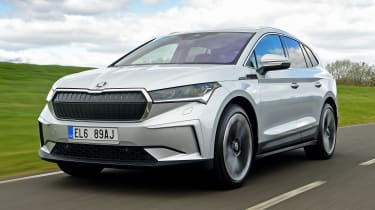
- Price: £42,170
- Power: 77kWh battery, 200bhp
For roughly the same price as these plug-in models, you could dip into the realms of EVs with the Enyaq iV. Its range of 329 miles will be fine for all but the longest of journeys, while the practical SUV body means it’s hugely versatile.
Used: Hyundai Santa Fe PHEV
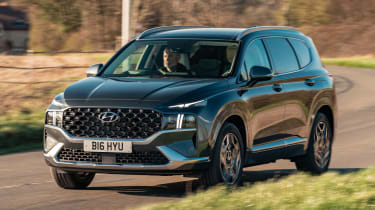
- Price: £44,500
- Engine: 1.6-litre 4cyl, 261bhp
If you’re in need of even more space, then the seven-seat Santa Fe uses the same plug-in hybrid powertrain as these two. A Premium-spec model is within budget, but it will be even more critical to keep it charged to benefit from the 36-mile EV range.
Figures
|
Kia Sportage 1.6 T-GDi PHEV 4 AWD |
Hyundai Tucson 1.6 T-GDi PHEV AWD Ultimate | |
|
On the road price/total as tested |
£42,550/£42,550 |
£42,380/£42,680 |
|
Residual value (after 3yrs/36,000) |
£24,168/56.8% |
£22,165/52.3% |
|
Depreciation |
£18,382 |
£20,215 |
|
Annual tax liability std/higher rate |
£680/£1,360 |
£1,016/£2,032 |
|
Annual fuel cost (12k/20k miles) |
£2,339/£3,898 |
£2,414/£4,024 |
|
Insurance group/quote/VED |
25/£768/£510 |
21/£852/£510 |
|
Cost of 1st/2nd/3rd service |
£624 (3yrs) |
£27pm (3yrs) |
|
Length/wheelbase |
4,515/2,680mm |
4,500/2,680mm |
|
Height/width |
1,650/1,865mm |
1,651/1,865mm |
|
Engine |
4cyl in-line/1,598cc |
4cyl in-line/1,598cc |
|
Peak power/revs |
261/5,500 bhp/rpm |
261/5,500 bhp/rpm |
|
Peak torque/revs |
350/1,500 Nm/rpm |
350/1,500 Nm/rpm |
|
Battery capacity |
13.8kWh |
13.8kWh |
|
Transmission |
6-spd auto/4WD |
6-spd auto/4WD |
|
Fuel tank capacity/spare wheel |
42 litres/repair kit |
42 litres/repair kit |
|
Boot capacity (seats up/down) |
540/1,715 litres |
558/1,737 litres |
|
Kerbweight/payload/towing weight |
1,905/510/1,350kg |
1,818/597/1,350kg |
|
Turning circle |
10.9 metres |
10.9 metres |
|
Basic warranty (miles)/recovery |
7yrs (100k)/1yr |
5yrs (unlimited)/1yr |
|
Driver Power manufacturer/dealer pos |
3rd/3rd (2021) |
11th/15th (2021) |
|
NCAP: Adult/child/ped./assist/stars |
87/86/66/72/5 |
86/87/66/70/5 |
|
0-60/62mph/top speed |
7.9 secs/119mph |
8.6 secs/120mph |
|
Auto Express economy/range |
44.6/9.8/412 miles |
43.2/9.5/399 miles |
|
WLTP combined |
252.0mpg |
201.8mpg |
|
EV range |
43 miles |
38 miles |
|
7kW charge time |
1h 45min |
1h 42min |
|
Actual/claimed CO2/tax bracket |
146/25g/km/8% |
151/31g/km/12% |
|
Airbags/Isofix/park sensors/camera |
Six/yes/f&r/yes |
Seven/yes/f&r/yes |
|
Auto box/lane keep/blindspot/AEB |
Yes/yes/yes/yes |
Yes/yes/yes/yes |
|
Climate control/adaptive cruise |
3-zone/yes |
3-zone/yes |
|
Leather/heated seats |
Part/four |
Yes/four |
|
Metallic paint/LED lights |
£650/yes |
£665/yes |
|
Keyless entry & go/powered tailgate |
Yes/yes |
Yes/yes |
|
Sat-nav/digital dash |
Yes/yes |
Yes/yes |
|
DAB radio/connected services |
Yes/7yrs |
Yes/5yrs |
|
Wireless charge/CarPlay/Android Auto |
Yes/yes/yes |
Yes/yes/yes |
